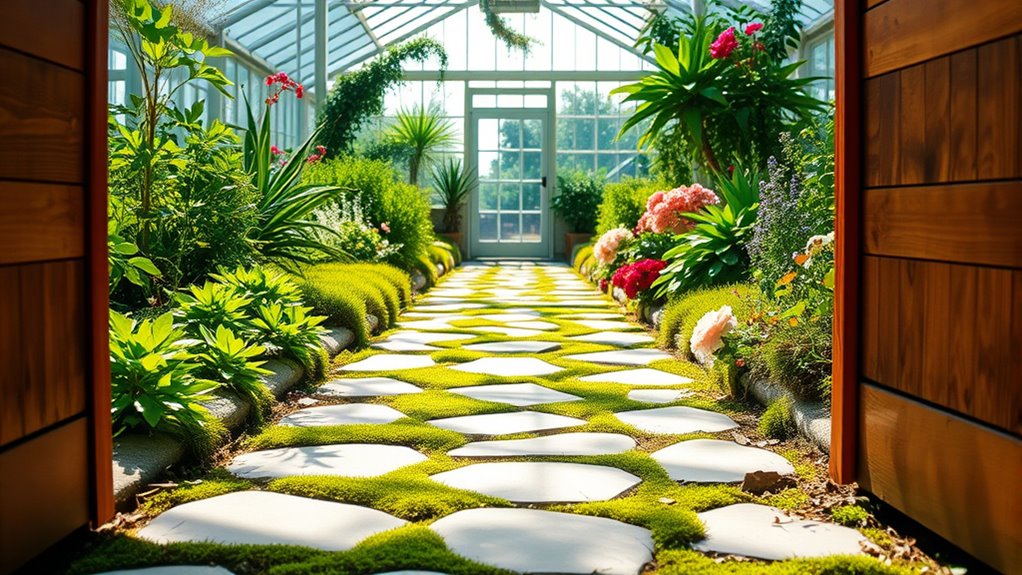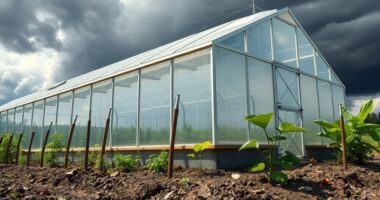When building a greenhouse pathway, you’ll want to choose materials like gravel for drainage or paving slabs for a polished look. Consider width for wheelchair access, and keep surfaces level for safety. Mixing textures can enhance visual appeal while proper drainage prevents water buildup. Opt for eco-friendly options like recycled materials to save costs and support sustainability. Want to ensure your pathway lasts and looks great? There’s more to explore on effective design strategies.
Key Takeaways
- Choose permeable materials like gravel or TRUEGRID pavers to enhance drainage and reduce runoff while ensuring stability.
- Design pathways at least 48 inches wide for accessibility, incorporating non-slip surfaces to prevent accidents.
- Optimize pathway layout by minimizing the number of paths and orienting them parallel to gutters for better airflow and access.
- Incorporate a mix of materials and textures for visual appeal, while considering local sourcing to support the community and reduce emissions.
- Plan for long-term durability by leveling the ground, ensuring proper drainage, and using materials that withstand weather and foot traffic.
Choosing the Right Materials for Your Pathway
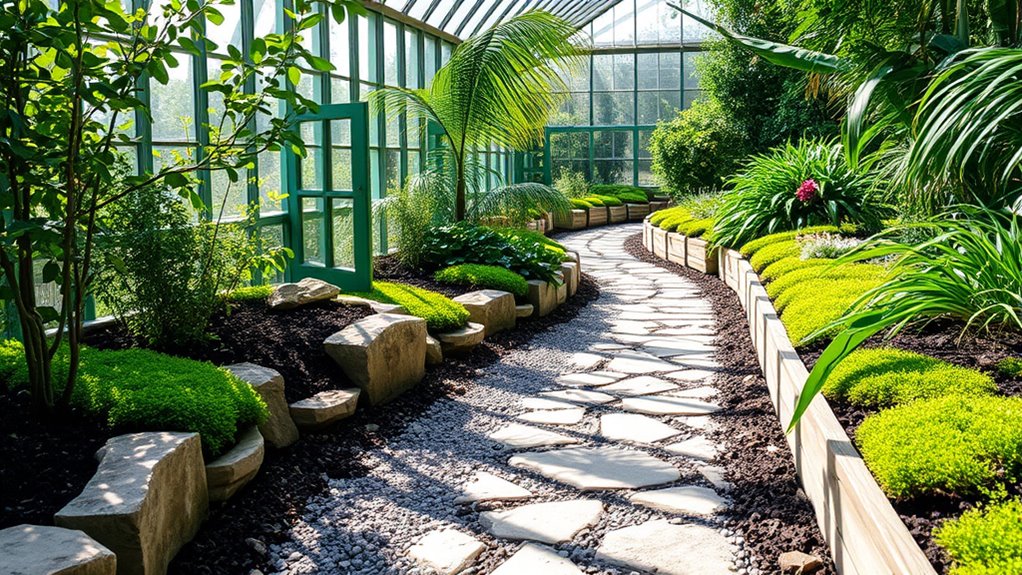
When you’re planning a pathway for your greenhouse, it’s essential to consider the materials you’ll use, as they can significantly impact durability, aesthetics, and maintenance.
Gravel and crushed stone offer great drainage and stability at a low cost, but you’ll need to manage occasional topping up. Additionally, using proper drainage techniques can further enhance the longevity of your pathway. Incorporating vegetarian options in your gardening can also promote sustainability and environmental health. Furthermore, using solar energy solutions can provide renewable energy to power your greenhouse efficiently. To maximize your savings, consider looking for discounted materials that can help reduce costs while maintaining quality.
Gravel and crushed stone provide excellent drainage and stability while remaining budget-friendly, though periodic topping up is necessary.
If you’re after a classic look, paving slabs or brick paths can enhance aesthetics, though they require construction skills and are pricier.
Wooden boards provide a rustic charm, but you’ll need to treat them regularly. Regular maintenance can prevent deterioration and ensure a lasting appeal.
For a temporary solution, polypropylene mats are easy to maintain.
Consider the environmental impact too; seashells can serve as an eco-friendly alternative to gravel.
Ultimately, choose a material that aligns with your path’s purpose and your budget. Additionally, exploring solar panel options can help you power your greenhouse sustainably while enhancing your gardening experience.
Design Considerations for Functionality
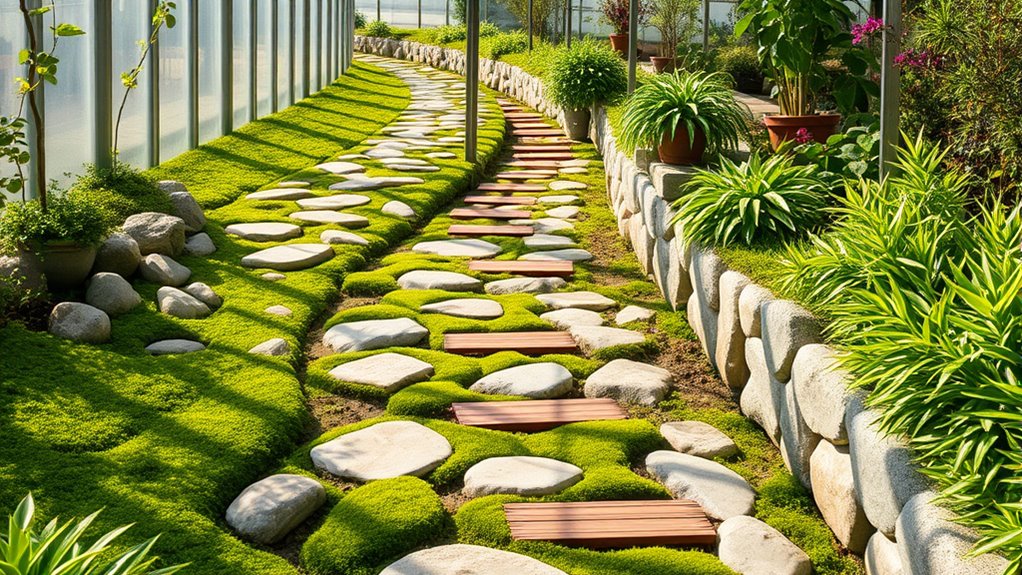
To create a functional greenhouse pathway, you’ll need to prioritize layout and accessibility. Optimize pathway width to ensure easy movement, especially when transporting equipment or harvesting.
Minimize the number of pathways to maximize floor space for planting. Orient pathways parallel to gutters to enhance airflow and access. Ensure smooth, level surfaces without obstacles to aid navigation, especially for those with limited mobility.
Consider group zoning for plants based on their needs, which facilitates care and management. Organize crop rows for easy access, minimizing transport distances.
Lastly, plan for maintenance access and store tools nearby to keep pathways clear, allowing for an efficient workflow that boosts productivity in your greenhouse.
Pathway Construction Techniques
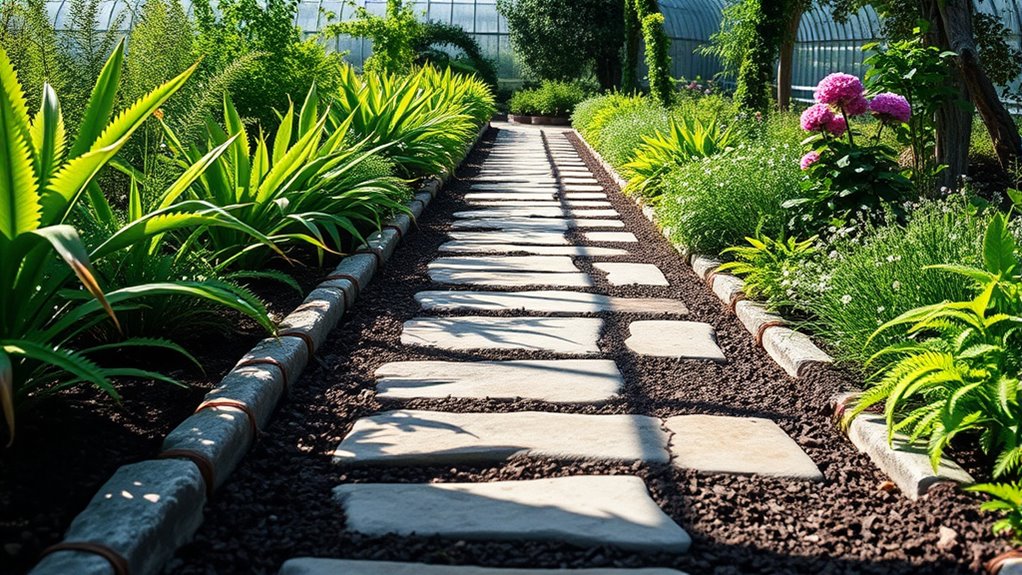
Creating effective pathways in your greenhouse involves careful construction techniques that ensure durability and functionality.
Start by leveling the ground to create a stable base. Lay down agrofibre to prevent weeds and enhance drainage before adding your chosen material.
If you opt for gravel or sand, compacting these materials is essential for stability. For bricks or stones, use sand to fill gaps and prevent shifting.
Don’t forget to install a proper drainage system to avoid water accumulation, which can damage your pathway and plants.
Regularly inspect your pathways for any unevenness or material degradation, making adjustments as necessary to keep them functional and safe for your greenhouse activities.
Ensuring Safety and Accessibility
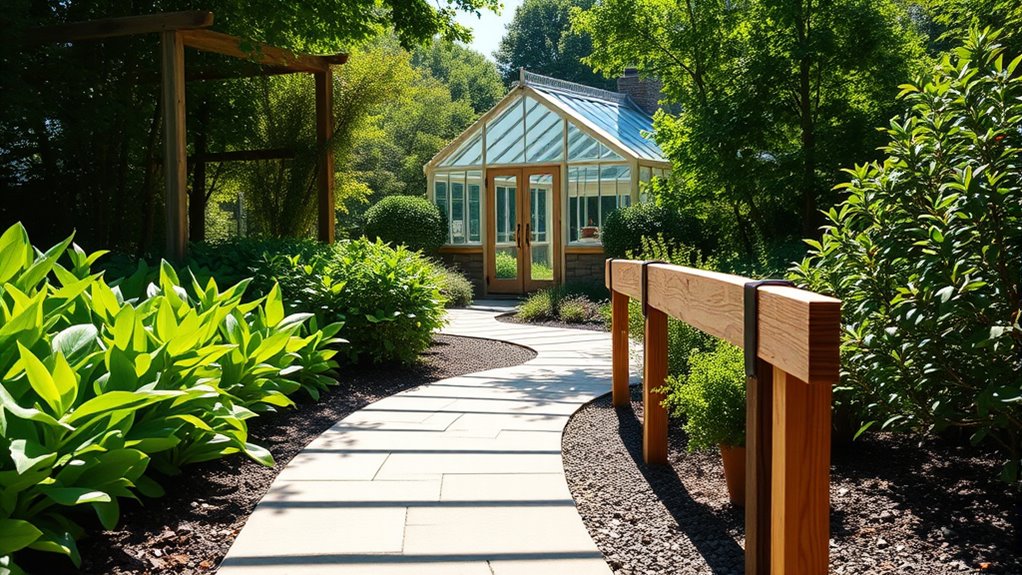
Ensuring safety and accessibility in your greenhouse pathways is crucial for a positive experience.
Make your pathways at least 48 inches wide to comfortably accommodate wheelchairs. Use non-slip surfaces like concrete or crushed rock to prevent accidents, and ensure good drainage to avoid water accumulation. Keep pathways clear of obstacles and maintain level ground to reduce tripping hazards.
Incorporate ramps with a gentle incline and install handrails for added support. Ensure doorways are at least 36 inches wide, and consider automatic doors for ease of access.
Use large, clear signage at eye level to guide visitors. Regularly check and maintain pathways and accessibility features to guarantee safe navigation for everyone.
Environmental and Budget-Friendly Options
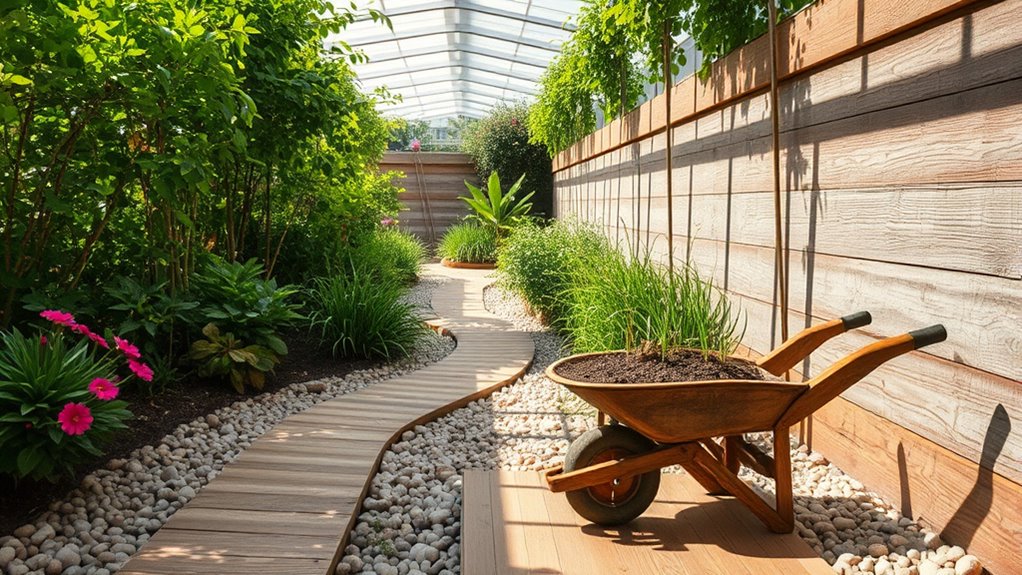
While building a greenhouse pathway, choosing environmental and budget-friendly options can significantly enhance both sustainability and cost-effectiveness.
Opt for permeable materials like porous asphalt or TRUEGRID pavers, which allow water to seep through, reducing runoff. Recycled asphalt and crushed stone not only cut costs but also lower environmental impact. Sourcing materials locally supports your community and decreases transportation emissions.
Additionally, consider using natural stone or reclaimed brick for a rustic feel without breaking the bank. Integrate vegetation between stones to boost biodiversity and soften the pathway’s look.
Creative Design Ideas for Unique Pathways
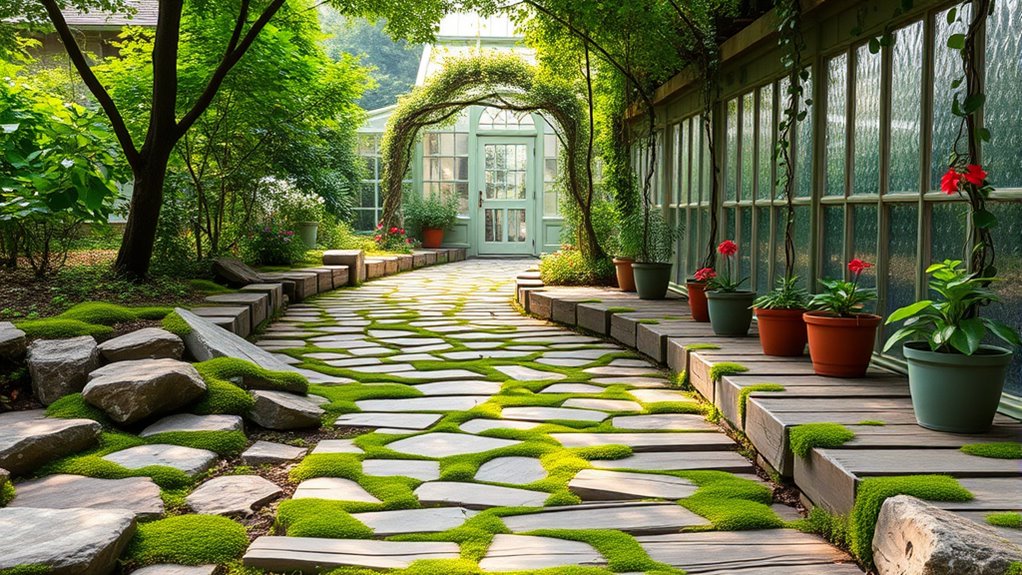
When you think about designing a unique pathway for your greenhouse, let your imagination run wild with creative possibilities.
Consider a rustic wooden deck entryway that invites visitors in or create a seamless patio connection, blending your greenhouse with the garden. An accessible ramp ensures everyone can enjoy your space, while enchanting steps made of stone or wood add charm. Incorporating a functional layout will not only enhance accessibility but also improve the overall flow of your garden space. Additionally, a well-planned pathway can help maximize sunlight exposure, benefiting the plants in your greenhouse. Choosing oak wood for your pathway materials can enhance durability and create a cohesive rustic aesthetic. Establishing clear rules and routines for garden maintenance can also contribute to the stability of your garden environment.
Vibrant flower-lined entryways not only attract pollinators but also brighten your path. Think about utilizing upcycled materials for a truly unique touch, and don’t forget solar-powered lighting for a magical glow at night. Incorporate decorative stepping stones or creeping thyme to enhance visual appeal, making your pathway both functional and aesthetically pleasing.
Additionally, you might draw inspiration from cultural festivals that celebrate local heritage, adding a unique touch to your pathway design.
Maintaining Your Greenhouse Pathway
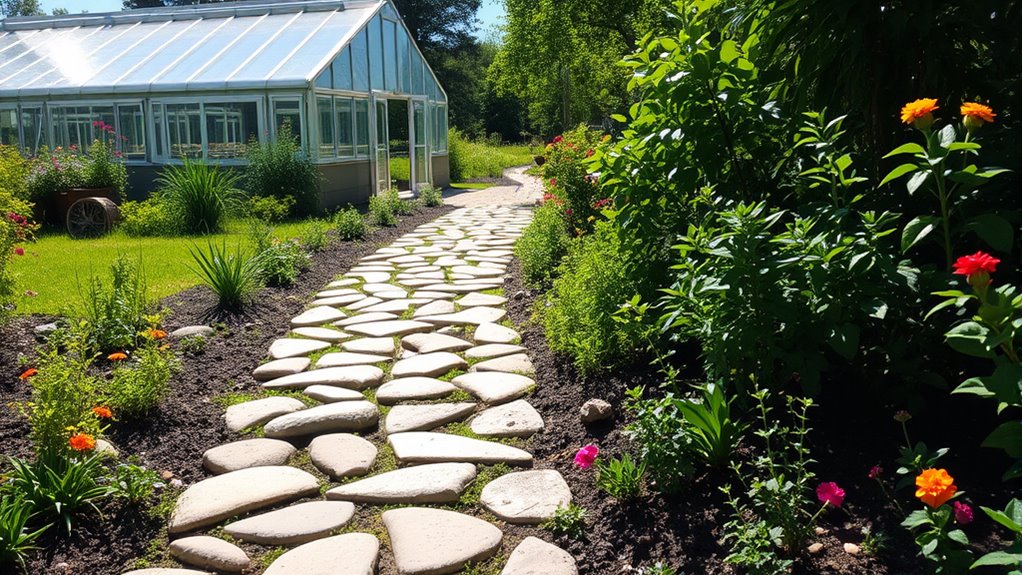
A beautifully designed pathway enhances your greenhouse experience, but maintaining it’s just as important for functionality and safety.
Regularly sweep and clear debris to keep pathways accessible and prevent disease spread. Inspect surfaces for damage and repair them promptly. Prune nearby plants to prevent overgrowth and use mulch to suppress weeds.
Ensure pathways are slightly sloped for effective drainage and use porous materials for better water management. Maintain smooth surfaces to avoid tripping hazards and consider applying non-slip coatings for wet conditions.
Regularly check widths for equipment access and clear signage to guide users. Adjust your maintenance routine seasonally to prepare for changes in weather and protect your pathways year-round. Additionally, consider using sustainable practices to choose materials for your pathways that minimize environmental impact.
Adapting to Climate Conditions
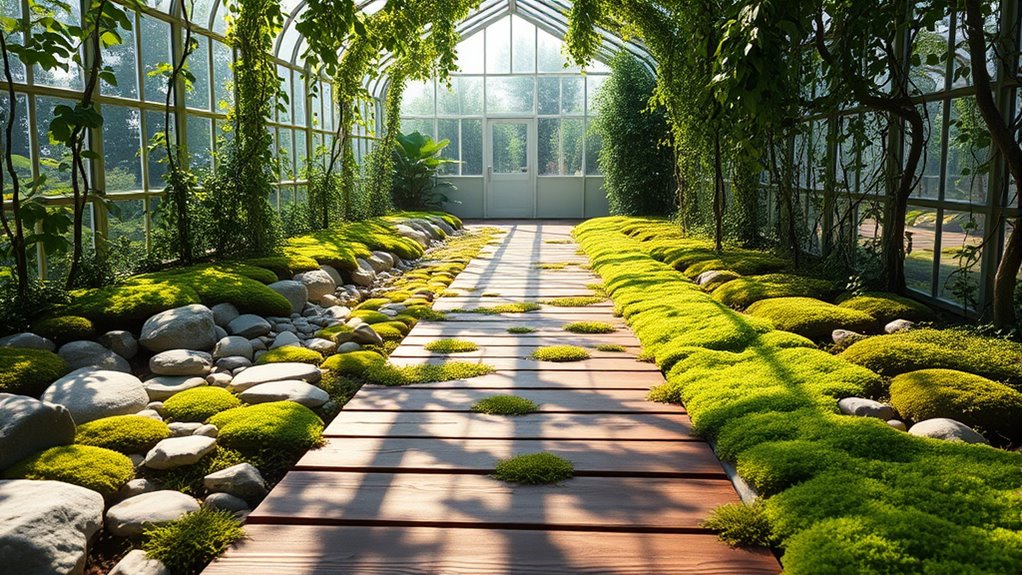
As climate change continues to impact our environment, adapting your greenhouse design becomes essential for maintaining productivity and sustainability. Increased temperatures and extreme weather events require you to implement flexible designs that can adjust as conditions evolve.
Combining mitigation efforts, like reducing emissions, with adaptation strategies ensures your greenhouse remains viable. Focus on creating climate-resilient pathways that allow for iterative management of change and vulnerabilities.
Proper insulation and ventilation help regulate temperature, while energy-efficient systems reduce fossil fuel reliance. Select durable materials that withstand harsh weather, and consider innovative technologies for added resilience.
Mixing Materials for Aesthetic Appeal
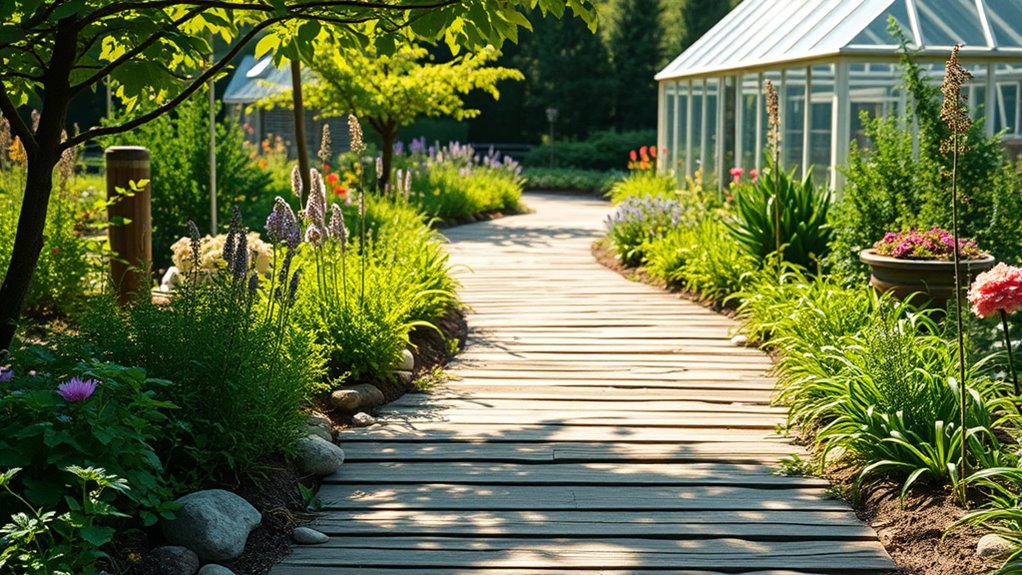
Mixing materials in your greenhouse pathway not only enhances its visual appeal but also creates a unique character that reflects your personal style.
Combining different textures, like gravel, stone, and wood, adds visual interest. You can blend colors, too; for instance, gray stone paired with vibrant flowers can brighten the space. A well-thought-out design can also incorporate natural materials like wood and stone, which are key to creating a rustic charm.
Creating patterns by alternating materials like brick and stone offers an artistic touch. Don’t forget to incorporate lighting—solar-powered lights can beautifully highlight your pathway at night.
Enhancing the area with greenery, such as flowers or shrubs, adds color and fragrance, making the pathway even more inviting. Additionally, a well-designed pathway can reduce stress levels, promoting a sense of calm as you navigate your greenhouse.
With these elements, you’ll craft a stunning and personalized greenhouse pathway that truly stands out.
Long-Term Planning for Pathway Durability
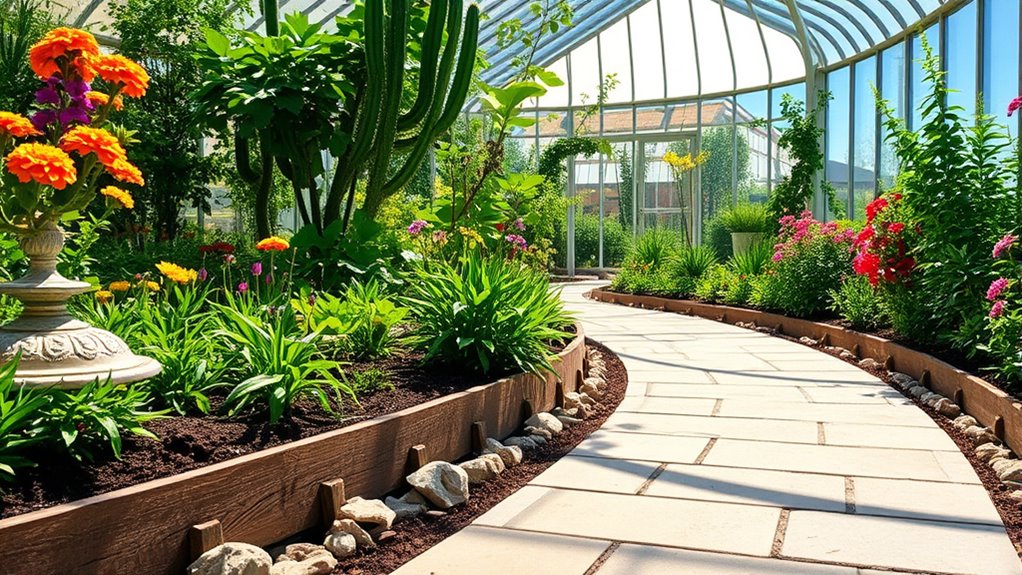
When planning your greenhouse pathway, considering long-term durability is essential for creating a functional and lasting space. Choose materials that withstand weather conditions and heavy foot traffic, like natural stone or permeable pavers.
Regular maintenance is crucial; inspect pathways often and make prompt repairs to prevent minor issues from escalating. Ensure proper drainage to avoid water accumulation and erosion, which can compromise structural integrity.
Additionally, think about sustainability—using recycled materials not only benefits the environment but can also be cost-effective.
Lastly, design pathways with future expansion in mind, so they adapt easily to your evolving needs. With careful planning, your greenhouse pathways will remain durable and aesthetically pleasing for years to come.
Frequently Asked Questions
What Tools Do I Need for Pathway Installation?
For pathway installation, you’ll need several essential tools.
Start with a shovel and rake for preparing the soil, then use a wheelbarrow to transport materials.
A tamping tool or plate compactor helps create a stable base.
You’ll also need a saw or cutter for cutting materials, and a drill for installation.
Finally, keep maintenance in mind with a broom and hose for cleaning, plus sealant to protect your pathway over time.
How Long Does Pathway Construction Typically Take?
You might think constructing a pathway would take ages, like waiting for your favorite TV show to return.
In reality, pathway construction typically takes just a few hours to a few days, depending on the complexity.
You’ll find that with careful planning and the right materials, you can create a functional and stylish pathway in no time.
Can I Install Pathways in Winter?
Yes, you can install pathways in winter, but it comes with challenges. Cold temperatures and frozen ground can complicate the installation process, making it difficult to secure materials.
You’ll need to ensure you have the right supplies available, as winter might limit options. Additionally, consider safety and accessibility to avoid slips during icy conditions.
With proper planning and the right materials, you can create effective pathways that withstand winter’s challenges.
What Are Common Mistakes to Avoid During Installation?
When installing a greenhouse, avoid common mistakes to ensure success.
Don’t rush your planning; take time to map out your design and gather materials. Ensure you’ve got the right tools and check weather conditions before starting.
Avoid using low-quality materials and make sure your site has adequate sunlight and good drainage.
Lastly, install proper ventilation to maintain a stable climate inside your greenhouse.
These steps will save you time and money in the long run.
How Do I Choose Plants for Pathway Edges?
When it comes to selecting plants for your pathway edges, think of it as inviting guests to a garden party.
You’ll want to choose a mix that suits your climate and adds charm. For sunny spots, consider colorful dahlias or resilient sedum.
In shaded areas, ferns or hostas can create a lush atmosphere.
Don’t forget about maintenance; low-maintenance options like creeping thyme keep your pathways looking fantastic without too much fuss.
Conclusion
In crafting your greenhouse pathway, remember that even the grandest gardens start with a single step. By choosing the right materials and designs, you’re not just building a pathway; you’re creating a journey through your green sanctuary. Embrace the blend of function and beauty, ensuring safety and sustainability along the way. Like a well-tended garden, your pathway will flourish with care and attention, guiding you through every season of growth. So, let’s get started on this rewarding adventure!
